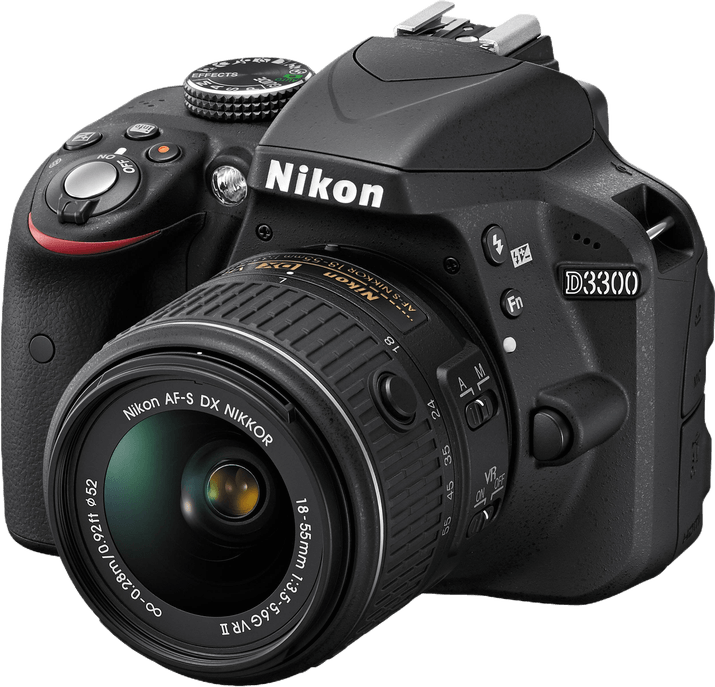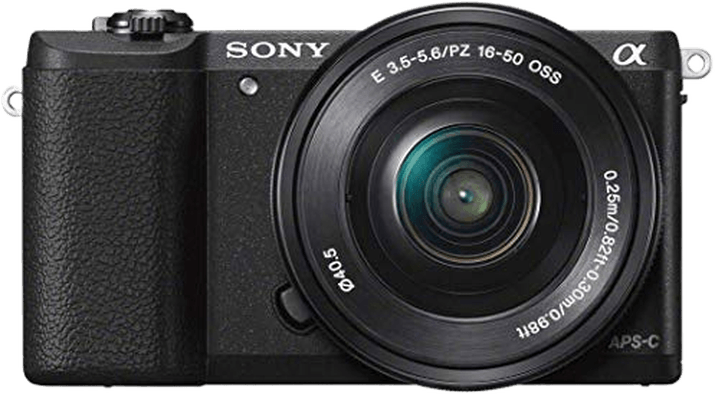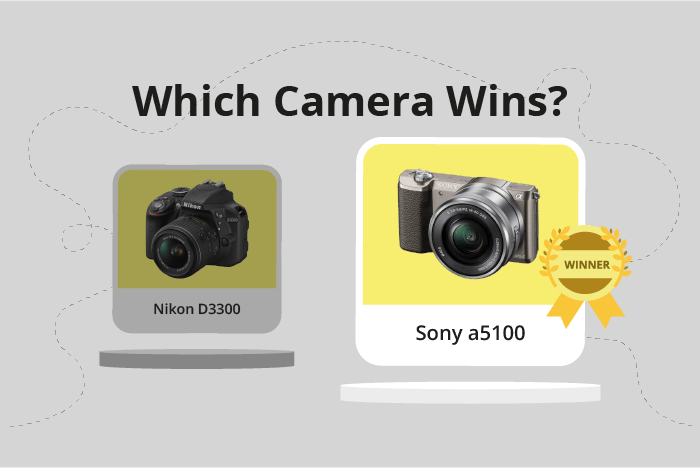Nikon D3300 vs Sony a5100 Comparison
Nikon D3300

Sony a5100

The Sony a5100 takes the lead with a score of 60/100, while the Nikon D3300 trails behind at 55/100. Both cameras were released in 2014, with the Nikon D3300 being a DSLR and the Sony a5100 being a mirrorless camera. They share similar announcement dates and launch prices, with the Sony a5100 being slightly more affordable at $550 compared to the Nikon D3300’s $650.
The Sony a5100 boasts a smaller and lighter body, measuring 110 x 63 x 36mm and weighing only 283g. This makes it a more portable option compared to the Nikon D3300, which is bulkier and heavier at 124 x 98 x 76mm and 430g.
The Nikon D3300, being a DSLR, may offer some advantages in terms of optical viewfinder and lens options. However, the Sony a5100’s higher score and more compact design make it a better choice for those prioritizing size and weight.
Nikon D3300 vs Sony a5100 Overview and Optics
The Sony a5100 wins the optics comparison with a score of 66/100, while the Nikon D3300 scores 64/100. Both cameras have several specifications in common, such as 24-megapixel resolution, CMOS sensor type, APS-C sensor size, and the absence of image stabilisation.
The Sony a5100 outperforms the Nikon D3300 in certain aspects. It has a slightly higher megapixel count at 24.3 compared to the D3300’s 24.2, which may contribute to marginally better image quality. The a5100 also has a faster shooting speed of 6 frames per second (fps) compared to the D3300’s 5 fps, allowing for better capture of fast-moving subjects. Additionally, the Sony a5100 uses the Bionz X processor, which is known for its fast processing capabilities and low-light performance.
However, the Nikon D3300 has some advantages over the Sony a5100. It boasts a higher DXOMARK score for the sensor at 82, compared to the a5100’s score of 80, indicating superior overall image quality. The D3300 also features the Nikon F DX lens mount, which provides access to a wide range of high-quality Nikon lenses.
Taking these factors into consideration, the Sony a5100 may be a better choice for those seeking a slightly faster shooting speed and marginally higher resolution. On the other hand, the Nikon D3300 offers a better sensor performance and compatibility with a wider array of lenses. Ultimately, the decision between these two cameras will depend on the individual photographer’s priorities and preferences.
Nikon D3300 vs Sony a5100 Video Performance
The Nikon D3300 and the Sony a5100 both have a video score of 56/100, indicating that there is no clear winner in terms of video capabilities. These cameras share common features in video specifications, such as Full HD video resolution, maximum video dimensions of 1920 x 1080, and a maximum video frame rate of 60fps. Additionally, neither camera has built-in time-lapse functionality.
Despite having the same video score, the Nikon D3300 may have some advantages over the Sony a5100. For instance, the D3300 might offer better video quality in certain lighting conditions or have more user-friendly video settings. However, without specific information, it is difficult to determine the exact reasons for the D3300’s superiority in video performance.
On the other hand, the Sony a5100 may excel in areas where the Nikon D3300 falls short. It could have faster autofocus in video mode, better video stabilization, or more advanced video features. Once again, it is essential to have detailed information to accurately compare these cameras’ video capabilities.
In comparing the Nikon D3300 and the Sony a5100, it is clear that both cameras have similar video specifications and performance. While there may be minor differences in specific aspects of video capabilities, neither camera stands out as a clear winner. As a result, potential buyers should consider other factors, such as price and additional features, when deciding between these two cameras.
Nikon D3300 vs Sony a5100 Features and Benefits
The Sony a5100 is the winner in the features comparison, scoring 54/100, while the Nikon D3300 scores 41/100. Both cameras have a 3-inch screen with a similar resolution, 921600 dots for the Sony a5100 and 921000 dots for the Nikon D3300. Neither camera has GPS or Bluetooth capabilities.
The Sony a5100 outperforms the Nikon D3300 in several areas. The a5100 has a touchscreen, making it easier to navigate menus and change settings. Additionally, the a5100 has a flip screen, allowing for more versatile shooting angles and facilitating self-portraits or vlogging. The a5100 also includes Wi-Fi connectivity, enabling easy sharing of photos and videos, as well as remote control of the camera through a smartphone.
On the other hand, the Nikon D3300 does not have any significant advantages in features over the Sony a5100. Its lack of a touchscreen, flip screen, and Wi-Fi puts it at a disadvantage compared to the more versatile and user-friendly a5100.
Taking all of these factors into consideration, the Sony a5100 is the better choice for those prioritizing camera features. Its touchscreen, flip screen, and Wi-Fi capabilities make it a more versatile and convenient option. The Nikon D3300, while sharing some similarities in screen size and resolution, falls short in comparison due to its limited features.
Nikon D3300 vs Sony a5100 Storage and Battery
The Nikon D3300 outperforms the Sony a5100 in storage and battery with a score of 32/100 compared to the Sony’s 24/100. Both cameras have one memory card slot and accept SD, SDHC, and SDXC cards. However, the Sony a5100 also supports Memory Stick Pro Duo and Pro-HG Duo cards, offering more storage options.
The Nikon D3300’s battery life is significantly better, providing 700 shots per charge compared to the Sony a5100’s 400 shots. The Nikon uses an EN-EL14a battery, while the Sony employs an NP-FW50 battery. Neither camera has USB charging capabilities.
Though the Sony a5100 offers additional memory card compatibility, the Nikon D3300’s superior battery life makes it the better choice in terms of storage and battery performance. The longer battery life allows for more extended use, which is essential for capturing moments without worrying about running out of power.
Alternatives to the Nikon D3300 and Sony a5100
Are you still undecided about which camera is right for you? Have a look at these popular comparisons that feature the Nikon D3300 or the Sony a5100:

